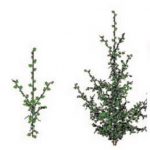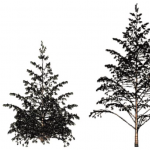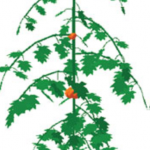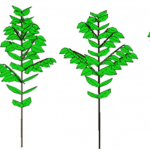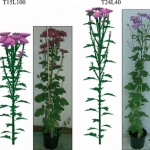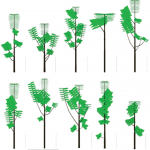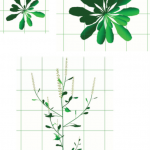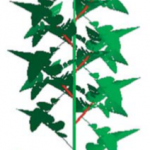GreenLab
P. de Reffye (CIRAD)
Overview
| Model category | FSPM |
|---|---|
| Plant part | Shoot |
| Scale | Organs, Whole_plant, Field |
| Licence | upon_request, freeware |
| Operating system | MacOs, Windows, Linux |
| Programming language | Matlab, Java, Cpp, Scilab |
| Format of model inputs and outputs | NA |
| Species studied | Wheat, Maize, Arabidopsis, Tomato, Tobacco, Teak, Coffee, Oilseed-rape, Chrysanthemum, Sunflower, Eucalyptus, Pine |
| Execution environment | Stand-alone application |
| Modelling environment | GreenLab |
Scientific article
A dynamic, architectural plant model simulating resource-dependent growthYan,H.-P.,Meng,Z.K.,De Reffye,P.,Dingkuhn,M.Annals of Botany, 2004 View paper
Model description
GreenLab is a generic and mechanistic FSPM: various botanical architectures, as defined by can be produced by its organogenesis model, and the plant growth is governed by the competition on biomass among growing organs.
GreenLab is a mathematical dynamic model aiming to model and simulate plant structure establishment and production. It differs from computational models by the fact that both development and functional processes are described by equations. The model therefore quantifies structure (the number of organs, etc.) without requiring exhaustive structural implementation. It also differs from classic functional structural plant models by the fact that organ production is quantified by compartments, competing for a common biomass pool. It also differs from biomass production based on the Beer Lambert Law, conventionally used in PBM. In a growth cycle, the model sequences organogenesis, biomass production and its partitioning in a dynamic loop.
The latest developments renew flexible structural representations and reconstructions.
Currently several levels of GreenLab model exist: (1) the deterministic one: plants have a fixed pattern for development without feedback from the plant growth; (2) the stochastic level: pant organogenesis parameters are probabilistic; (3) the feedback model (still on development): the plant development is dependent on the dynamic relationship between biomass demand and supply (and in turn the environment). It makes it possible to cover the different kinds of behaviour observed in real plants.
Some case studies
Some recent studies using GreenLab:
- Kang M, Hua J, Wang X, et al (2018) Estimating Sink Parameters of Stochastic Functional-Structural Plant Models Using Organic Series-Continuous and Rhythmic Development. Front Plant Sci 9:1688. doi: 10.3389/fpls.2018.01688
- Tondjo K, Brancheriau L, Sabatier S, et al (2018) Stochastic modelling of tree architecture and biomass allocation: application to teak (Tectona grandis L. f.), a tree species with polycyclic growth and leaf neoformation. Annals of Botany 121:1397–1410. doi: 10.1093/aob/mcy040
- Vavitsara, M. E., Sabatier, S.-A., Kang, M., Ranarijaona, H. L., de Reffye, P., 2017. Yield analysis as a function of stochastic plant Architecture: Case of Spilanthes acmella in the wet and dry season. Computers and Electronics in Agriculture, 138 (1) : 105-116.
- Zang, X.-P., Bao, G.-B., Meng, W.-L., Jaeger, M., Li, H.-J., Deussen, O., and Chen, B.-Q., 2017. Tree Branch Level of Detail Models for Forest Navigation. Computer Graphics Forum, 2017, DOI: 10.1111/cgf.130 http://onlinelibrary.wiley.com/doi/10.1111/cgf.13088/full
- Okoma, P., Akaffou, S., de Reffye, P., Hamon, P., Hamon, S., Konan, O., Kouassi, K. H., Legnate, H., Letort, V., Sabatier, S.-A., 2016. Estimation of stem and leaf dry biomass using a non-destructive method applied to African Coffea species. Agroforestry Systems, Online : https://link.springer.com/content/pdf/10.1007%2Fs10457-016-0031-z.pdf
- Taugourdeau, O., Caraglio, Y., Sabatier, S., Guédon, Y., 2015. Characterizing the respective importance of ontogeny and environmental constraints in forest tree development using growth phase duration distributions. Ecological Modelling, 300 : pp. 61-72
- Chew, Y. H., Wenden, B., Fils, A., Mengin, V., Taylor, J., Davey, C. L., Tindal, C., Thomas, H., Ougham, H. J., de Reffye, P., Stitt, M., Williams, H., Muetzelfeldt, R., Haliday, K. J., Milar, A. J., 2014. Multiscale digital Arabidopsis predicts individual organ and whole-organism growth. Proceedings of the National Academy of Sciences of the United States of America (PNAS), 111 (39) : E4127-E4136.
- Feng, L. , Mailhol, J. C. , Rey, H., Griffon, S., Auclair, D., de Reffye, P., 2014. Comparing an empirical crop model with a functional structural plant model to account for individual variability. European Journal of Agronomy, 53 (1) : 16-27.
http://www.sciencedirect.com/science/article/pii/S116103011300155X
- Guilhem Brunel, Philippe Borianne, Gérard Subsol, Marc Jaeger, Yves Caraglio., 2014. Automatic Identification and Characterization of Radial File in Light Microscopic Images of Wood. Annals of Botany, 114 (4), pp. 829-840
http://aob.oxfordjournals.org/content/early/2014/07/02/aob.mcu119.short
- Wang, X. J., Mathieu, A., Cournède, P. H., de Reffye, P., 2014. Application of a probabilistic model for analysing the abortion of seeds and pods in winter oilseed rape (Brassica napus). Annals of Applied Biology, 165 (3) : 414-428
- Feng, L., Mailhol, J.-C., Rey, H., Griffon, S., Auclair, D., De Reffye, P., 2013. Comparing an empirical crop model with a functional structural plant model to account for individual variability. In: The European Journal of Agronomy, No 53, 2014, pp. 16-27. Url: http://dx.doi.org/10.1016/j.eja.2013.11.005
- Andrianasolo, D., Davis, A. P., Razafinarivo, N. J., Hamon, S., Rakotomalala, J. J. , Sabatier, S., Hamon, P., 2013. High genetic diversity of in situ and ex situ populations of Madagascar coffee species: further implications for the management of coffee genetic resources. Tree Genetics and Genomes, 9 (5) : pp. 1295-1312
- Kang, M., Heuvelink, E., Carvalho, S. M. P. and de Reffye, P. A virtual plant that responds to the environment like a real one: the case for chrysanthemum. New Phytologist, 195: pp. 384-395. Doi: 10.1111/j.1469-8137.2012.04177.x Url: http://onlinelibrary.wiley.com/doi/10.1111/j.1469-8137.2012.04177.x/abstract
- L. Wu, F.-X. Le Dimet, P. de Reffye, B.-G. Hu, P.-H. Cournède and M.-Z. Kang. An optimal control methodology for plant growth. Case study of a water supply problem of sunflower. Mathematics and Computers in Simulation, Volume 82, Issue 5, January 2012, pp. 909-923, ISSN 0378-4754, 10.1016/j.matcom.2011.12.007. Url: http://www.sciencedirect.com/science/article/pii/S0378475412000109
- Jun Diao, Philippe De Reffye, Xiangdong Lei, Hong Guo, Véronique Letort. Simulation of the topological development of young eucalyptus using a stochastic model and sampling measurement strategy. Computers and Electronics in Agriculture, Volume 80, January 2012, pp. 105-114, ISSN 0168-1699, 10.1016/j.compag.2011.10.019. Url: http://www.sciencedirect.com/science/article/pii/S016816991100247X
- Wang F, Letort V, Lu Q, Bai X, Guo Y, et al. A Functional and Structural Mongolian Scots Pine (Pinus sylvestris var. mongolica) Model Integrating Architecture, Biomass and Effects of Precipitation. 2012. PLoS ONE 7(8): e43531. Doi:10.1371/journal.pone.0043531 Url: http://www.plosone.org/article/info%3Adoi%2F10.1371%2Fjournal.pone.0043531
-Jullien A, Mathieu A, Allirand J-M, et al (2011) Characterization of the interactions between architecture and source–sink relationships in winter oilseed rape (Brassica napus) using the GreenLab model. Annals of Botany 107:765–779. doi: 10.1093/aob/mcq205
- Kang M, Wang X, Qi R, Reffye P de (2009) GreenScilab-Crop, an open source software for plant simulation and parameter estimation. In: 2009 IEEE International Workshop on Open-source Software for Scientific Computation (OSSC). IEEE, Guiyang, China, pp 91–95
- Dong Q, Louarn G, Wang Y, et al (2007) Does the Structure-Function Model GREENLAB Deal with Crop Phenotypic Plasticity Induced by Plant Spacing? A Case Study on Tomato. Annals of Botany 101:1195–1206. doi: 10.1093/aob/mcm317
